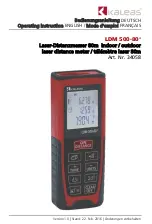
Lynx Setup for Administrators and Users
Lynx DSA User's Manual - 9240227J
67
Communication Interfaces
To use any of Lynx's communications interfaces, connect the supplied cable between
the Lynx and another device, such as a hub or the host computer. The
Communications Setup Appendix
starting on page 150 describes the initial setup and
basic operation of each of these interfaces.
Ethernet
Lynx supports 10/100 Base-T Ethernet for connecting to an existing Ethernet
network using an Ethernet patch cable (color varies), or directly to a host computer
using an Ethernet crossover (red color) cable.
One 3 m (10 ft) 10/100 Base-Tx UTP Ethernet patch cable, and one 3 m (10 ft)
10/100 Base-Tx UTP Ethernet crossover cable (red in color) are supplied.
RS-232
RS-232 for serial data communications. One 3 m (10 ft) RS-232 9-pin 'null modem'
cable is supplied.
To use the RS-232 interface, you'll have to create a direct serial connection on your
PC. This involves setting up a RAS account. Please refer to
Windows RAS Settings
for RS-232 Use
on page 170 for instructions.
USB
USB D is for connecting the Lynx as a Device to a USB hub or directly to a host
computer. One 3 m (10 ft) conventional USB A-B cable is supplied.
Before you can use the USB interface, you'll have to set up your computer’s USB
connection for operation with RNDIS protocol. USB setup instructions are found in
Setting Up a USB Connection
on page 163.
Lynx Setup for Administrators and Users
A brief overview of the Lynx Web Client Interface is given on page 9. This section
provides instructions of how to connect your Lynx to the Lynx Web Client Interface.
Although most of the operation of the Lynx Web Client application will be covered
in this document, additional information on using the application and algorithms used
by the application can be found in the
Lynx Web Client User's Manual.pdf
included
in the CD.
If you have a single Lynx connected to a dedicated network whose addresses are
managed by you, then the factory default settings could suffice. More often than not,
it is typically the case that the Lynx will be connected to a network with other
devices, in which case the address of each may be dynamically assigned by network’s
DHCP server, or must be manually assigned to eliminate address contentions.
















































